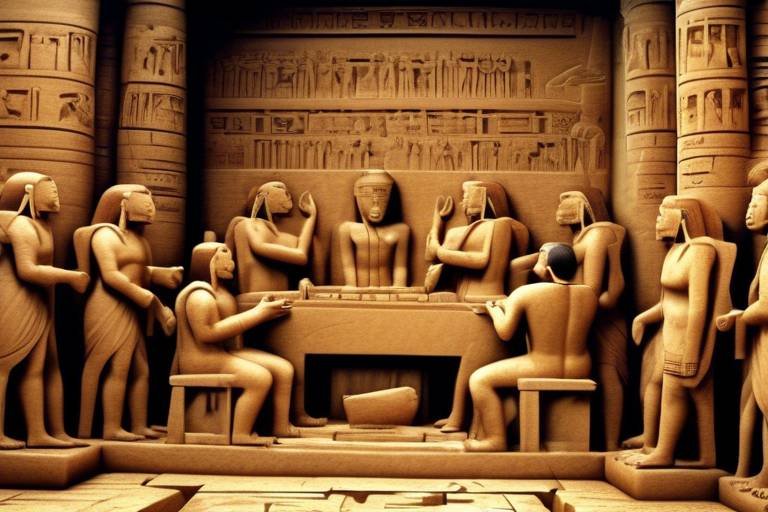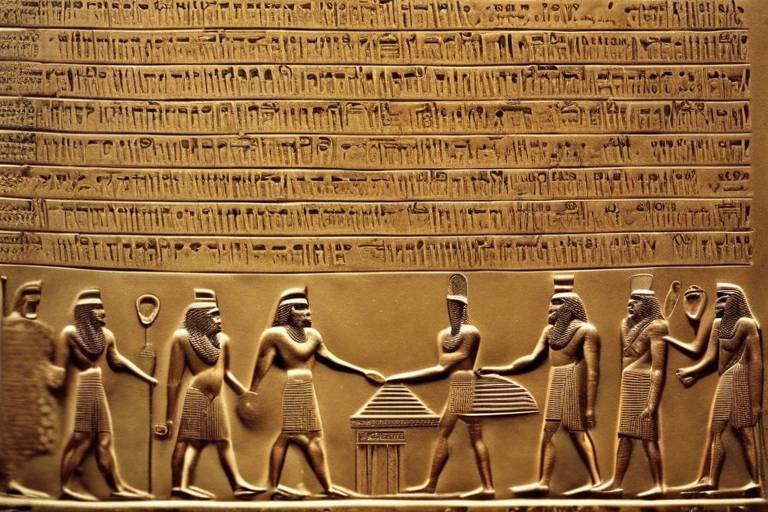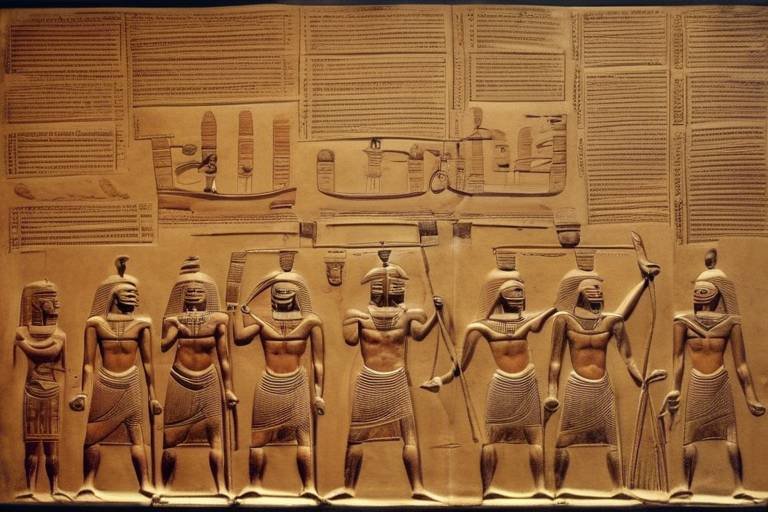The Secrets of Ancient Civilizations' Innovations in Technology
Ancient civilizations hold within their grasp the secrets of remarkable technological innovations that continue to captivate and inspire modern minds. These ancient societies, with their ingenuity and resourcefulness, paved the way for the technological advancements we enjoy today. Let's delve into the fascinating world of ancient civilizations and uncover the mysteries behind their technological feats.
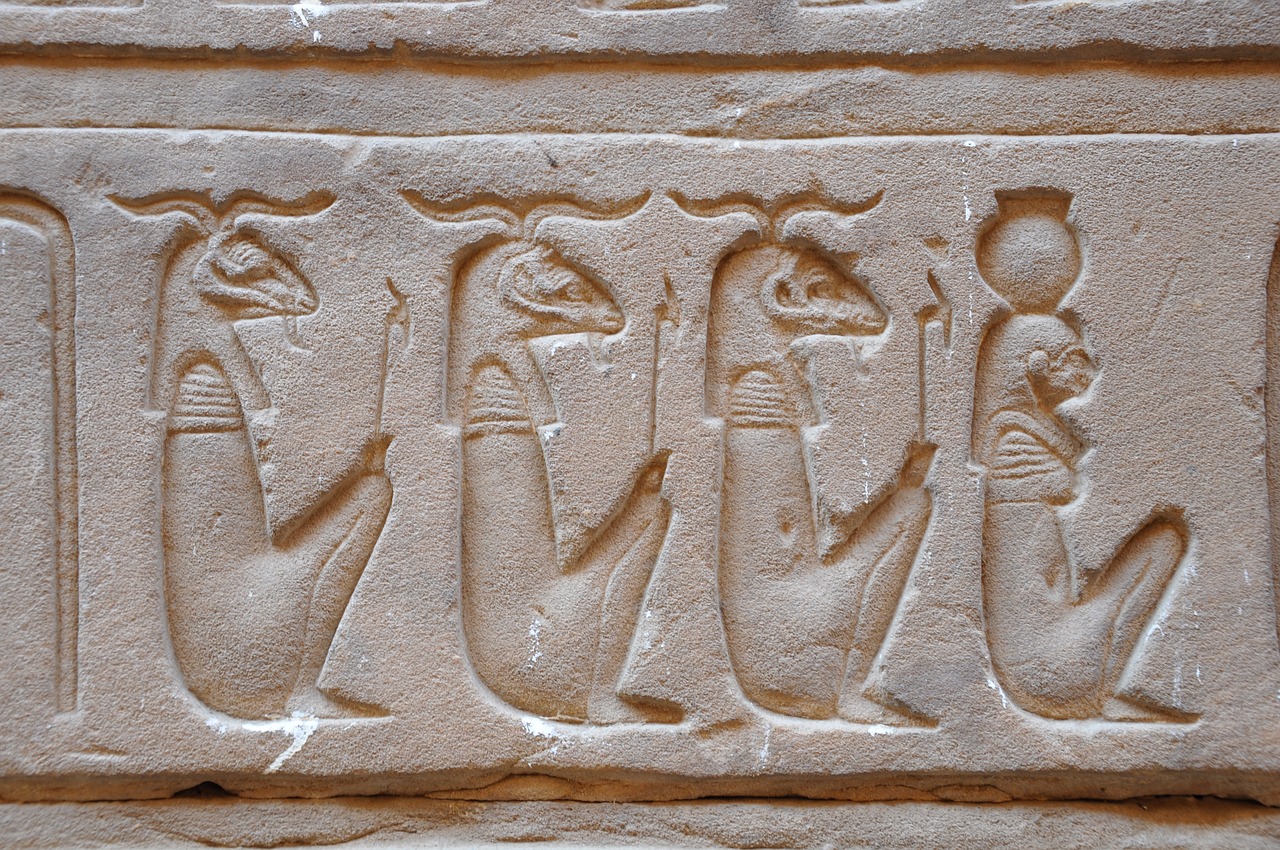
Egyptian Innovations
When it comes to ancient civilizations, the innovations and technological advancements of the Egyptians stand out as truly remarkable. The engineering marvels of ancient Egypt continue to captivate and inspire us to this day. From the awe-inspiring construction of the pyramids to the intricate development of hieroglyphics, the Egyptians were pioneers in various fields of technology and engineering.
One of the most iconic symbols of ancient Egyptian innovation is the Great Pyramid of Giza, a testament to their architectural prowess and engineering skills. The precision with which the pyramids were built still baffles experts, showcasing the advanced knowledge and techniques possessed by the ancient Egyptians. Additionally, the Egyptians were pioneers in irrigation systems, utilizing the Nile River to develop sophisticated methods of water management for agriculture and daily life.
The Egyptians also made significant advancements in written communication through the development of hieroglyphics. These intricate symbols not only served as a form of writing but also as a means of artistic expression and storytelling. The intricate nature of hieroglyphics reflects the Egyptians' attention to detail and their desire to preserve knowledge and history for future generations.
Exploring the technological innovations of ancient Egypt is like uncovering a treasure trove of ingenuity and creativity. The legacy of their achievements continues to influence modern technology and engineering practices, reminding us of the enduring impact of ancient civilizations on our world today.

Greek Contributions
Greek civilization has left a lasting legacy in the field of technology and science, with numerous groundbreaking contributions that continue to influence modern society. One of the most notable inventions of ancient Greece is the astrolabe, a sophisticated device used for navigating the stars and determining celestial positions. This innovative tool revolutionized astronomy and navigation, laying the foundation for future advancements in these fields.
In addition to the astrolabe, the Greeks also developed the water mill, a revolutionary invention that harnessed the power of water to grind grain and perform various other tasks. This early form of mechanical engineering paved the way for the development of more complex machinery in later centuries, shaping the industrial landscape of the ancient world.
Furthermore, Greek mathematicians and scholars made significant contributions to the fields of geometry and mathematics. Figures like Euclid and Pythagoras introduced fundamental principles and theorems that are still taught in schools today. Their work not only advanced mathematical knowledge but also laid the groundwork for modern scientific inquiry and problem-solving methodologies.
The Greeks' insatiable curiosity and innovative spirit led to the creation of technologies that were ahead of their time, demonstrating a remarkable level of ingenuity and creativity. Their legacy continues to inspire and inform contemporary scientific and technological advancements, serving as a testament to the enduring impact of ancient civilizations on the modern world.

Roman Engineering Feats
The Romans were renowned for their incredible engineering feats that have stood the test of time and continue to amaze us today. One of their most remarkable achievements was the construction of aqueducts, which were elaborate systems designed to transport water over long distances to supply cities and towns with fresh water. These aqueducts showcased the Romans' mastery of engineering and architecture, utilizing precise calculations and innovative techniques to create structures that have endured for centuries.
In addition to their aqueducts, the Romans were also pioneers in road construction. They built an extensive network of roads that connected their vast empire, facilitating trade, communication, and military movement. These roads were constructed with meticulous attention to detail, incorporating layers of materials such as gravel, sand, and stones to ensure durability and stability. The Roman roads were a testament to their engineering prowess and strategic planning, demonstrating their commitment to efficiency and connectivity.
Furthermore, the Romans excelled in bridge building, creating sturdy and durable structures that spanned rivers and valleys. Their bridges were constructed using a combination of stone and concrete, showcasing their innovative use of materials and engineering techniques. These bridges not only provided essential transportation links but also served as architectural marvels, blending functionality with aesthetic appeal.
Another significant contribution of Roman engineering was their pioneering use of concrete in building construction. The Romans developed a unique form of concrete that allowed them to create large, complex structures such as amphitheaters, temples, and baths. This revolutionary building material enabled the Romans to construct monumental edifices with intricate designs and impressive scale, showcasing their ingenuity and architectural vision.
In conclusion, the Roman engineering feats continue to inspire admiration and awe for their ingenuity, precision, and enduring legacy. From aqueducts to roads, bridges, and concrete structures, the Romans left a lasting imprint on the field of engineering and architecture, setting a standard of excellence that has withstood the test of time.

Mayan Technological Advancements
The Mayan civilization, known for its advanced technological achievements, made significant contributions to various fields that continue to intrigue researchers and historians today. One of the most notable advancements was in astronomy, where the Mayans developed a sophisticated understanding of celestial bodies and their movements. Their precise observations allowed them to create complex calendars that accurately predicted astronomical events.
In addition to astronomy, the Mayans excelled in mathematics, developing a numeral system that included the concept of zero. This innovation was revolutionary and laid the foundation for advanced mathematical calculations and measurements. The Mayans also made significant progress in the field of architecture, constructing impressive cities and temples with intricate designs and precise alignments to astronomical phenomena.
Furthermore, the Mayans were skilled in agriculture, implementing advanced techniques such as terracing to maximize crop yields in challenging terrains. Their expertise in cultivating crops like maize, beans, and squash enabled them to sustain large populations and build thriving urban centers.
Aside from their technological achievements, the Mayans were also adept at creating intricate artwork and pottery, showcasing their artistic talents and cultural sophistication. Their intricate designs and symbolic motifs reflected their deep connection to nature and spiritual beliefs.
Overall, the Mayan civilization's technological advancements were truly remarkable, demonstrating their ingenuity and creativity in various fields. Their legacy continues to inspire modern researchers and engineers, highlighting the enduring impact of ancient civilizations on our world today.

Chinese Inventions and Discoveries
When delving into the annals of history, one cannot overlook the profound impact of Chinese innovations and discoveries on the course of technological evolution. The ancient Chinese civilization stands as a beacon of ingenuity, credited with a myriad of groundbreaking inventions that have shaped the modern world as we know it.
One of the most significant contributions of ancient China to the realm of technology is the invention of paper. Prior to this revolutionary development, various materials such as bamboo strips, silk, and parchment were used for writing. However, the invention of paper during the Han Dynasty marked a pivotal moment in human history, facilitating the spread of knowledge and literacy on a mass scale.
Furthermore, the Chinese are also credited with the creation of the compass, a navigational instrument that revolutionized maritime exploration and trade. By harnessing the Earth's magnetic field, the Chinese were able to develop a tool that enabled sailors to navigate with precision, opening up new horizons and connecting distant lands.
Another groundbreaking discovery originating from ancient China is the invention of gunpowder, a transformative development that forever altered the course of warfare and technological progress. The utilization of gunpowder in weaponry catapulted military capabilities to new heights, reshaping the dynamics of conflict and conquest.
Moreover, the Chinese civilization's mastery of silk production techniques revolutionized the textile industry, introducing luxurious and durable fabrics that became highly sought after commodities both domestically and internationally. The intricate process of silk production, closely guarded by the Chinese for centuries, exemplifies their unparalleled craftsmanship and attention to detail.
In essence, the legacy of Chinese inventions and discoveries serves as a testament to the boundless creativity and ingenuity of ancient civilizations. From paper to gunpowder, compasses to silk, the technological prowess of ancient China continues to inspire awe and admiration, underscoring the enduring impact of their innovations on the tapestry of human history.

Indus Valley Civilization's Achievements
The Indus Valley Civilization, one of the oldest known civilizations, boasts a myriad of remarkable technological achievements that continue to intrigue historians and archaeologists alike. Renowned for their advanced urban planning, the Indus Valley people constructed well-organized cities with sophisticated drainage systems and efficient water management techniques. The layout of their cities, such as Mohenjo-Daro and Harappa, showcases a level of meticulous planning that was unparalleled during that era.
Moreover, the Indus Valley Civilization's expertise in sewage systems is evident in the intricate network of underground drains found in their cities. These well-engineered systems not only facilitated waste disposal but also contributed to maintaining cleanliness and hygiene within their urban centers. The ingenuity displayed in the design and implementation of these sewage systems highlights the advanced technological prowess of the Indus Valley people.
Additionally, the civilization's mastery of water management is exemplified by the construction of reservoirs and water tanks to store and distribute water efficiently throughout their settlements. The utilization of advanced hydraulic engineering techniques allowed them to harness the power of rivers like the Indus and its tributaries for agricultural purposes and domestic use, showcasing their deep understanding of hydrology and irrigation practices.
Furthermore, the Indus Valley Civilization's achievements in metallurgy and craftsmanship are evident in the intricate artifacts and tools discovered at archaeological sites. Their expertise in working with metals like copper, bronze, and gold enabled them to create a wide range of tools, ornaments, and ceremonial objects, showcasing their advanced metallurgical skills and artistic sensibilities.
In conclusion, the technological achievements of the Indus Valley Civilization stand as a testament to their ingenuity, innovation, and advanced understanding of engineering principles. Their contributions to urban planning, water management, sewage systems, and metallurgy demonstrate a level of sophistication that continues to fascinate researchers and inspire admiration for the ancient civilization's technological prowess.
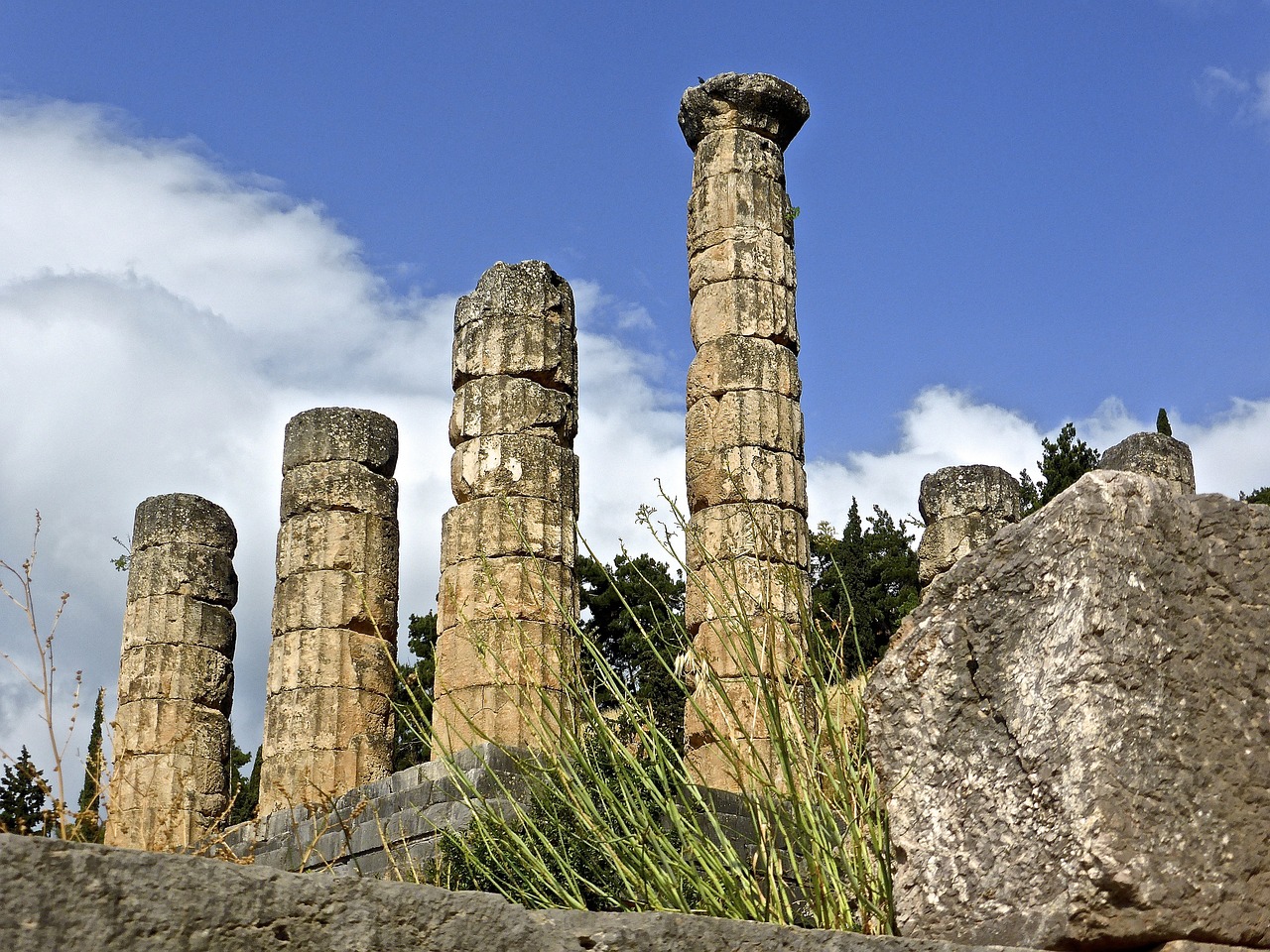
Inca Engineering Marvels
The Inca civilization is renowned for its incredible engineering marvels that continue to fascinate and inspire people to this day. One of the most iconic achievements of the Incas is the construction of Machu Picchu, a breathtaking citadel perched high in the Andes mountains. The precision and ingenuity displayed in building this complex structure without the use of modern technology is truly remarkable.
Another impressive aspect of Inca engineering is their innovative agricultural terracing methods. The Incas transformed steep mountain slopes into fertile terraced fields, allowing them to grow crops at high altitudes where traditional farming would have been impossible. This intricate system of terraces not only provided sustenance for the population but also helped prevent soil erosion in the mountainous terrain.
Furthermore, the Incas developed an extensive road network that connected their vast empire, stretching thousands of miles across diverse landscapes. These roads were meticulously constructed, often carved into mountainsides or paved with stones, showcasing the Inca's expertise in engineering and transportation.
Overall, the Inca civilization demonstrated a mastery of engineering and construction that rivaled any other ancient civilization. Their ability to create complex structures in challenging environments and develop sophisticated agricultural and transportation systems is a testament to their ingenuity and advanced technological knowledge.

Babylonian Contributions to Mathematics
The ancient Babylonians made significant contributions to the field of mathematics, laying the foundation for many mathematical concepts still used today. One of their most notable achievements was the development of the base-60 numerical system, which formed the basis for our modern system of time measurement and angles in geometry. This innovative system allowed for more complex calculations and precise measurements, revolutionizing the way mathematical problems were approached and solved.
In addition to their numerical system, the Babylonians also made advancements in algebra, introducing techniques for solving equations and problems involving unknown quantities. They developed methods for finding solutions to quadratic equations and geometric problems, paving the way for the evolution of algebraic principles in mathematics.
Furthermore, the Babylonians were adept at calculating the areas of geometric shapes, demonstrating a deep understanding of mathematical concepts related to geometry and spatial measurements. Their mathematical prowess extended to the realm of astronomy, where they used complex calculations to track celestial movements and develop calendars based on astronomical observations.
Their contributions to mathematics not only influenced the development of ancient civilizations but also laid the groundwork for future mathematical discoveries and innovations. The legacy of Babylonian mathematics continues to inspire mathematicians and scholars to this day, showcasing the enduring impact of their intellectual achievements on the field of mathematics.
Frequently Asked Questions
- What are some notable technological advancements of the ancient Egyptians?
Ancient Egyptians were known for their impressive engineering feats, such as the construction of the pyramids, development of hieroglyphics for written communication, and advancements in irrigation systems to support agriculture along the Nile River.
- What scientific achievements can be attributed to ancient Greece?
Ancient Greece made significant contributions to science, including the invention of the astrolabe for navigation, development of the water mill for various industrial purposes, and foundational work in geometry and mathematics that laid the groundwork for modern mathematical principles.
- What were some notable engineering accomplishments of the Romans?
The Romans were known for their architectural prowess, particularly in the construction of aqueducts to transport water over long distances, building sturdy roads and bridges for efficient transportation, and pioneering the use of concrete as a versatile building material in their structures.
- What technological innovations are associated with the Mayan civilization?
The Mayans were advanced in astronomy, mathematics, and timekeeping, creating intricate calendars and timekeeping systems that showcased their sophisticated understanding of celestial movements and mathematical concepts.
- What are some key inventions and discoveries from ancient China?
Ancient China is credited with inventing paper, the compass for navigation, gunpowder for military and fireworks, and developing silk production techniques that revolutionized the textile industry.
- What technological achievements are notable in the Indus Valley Civilization?
The Indus Valley Civilization excelled in urban planning with well-organized cities, advanced sewage systems for sanitation, and sophisticated drainage and water management techniques that showcased their engineering prowess.
- What engineering marvels are associated with the Inca civilization?
The Incas are known for their impressive construction of Machu Picchu, innovative agricultural terracing methods to maximize crop yields in mountainous regions, and extensive road networks that facilitated communication and trade within their empire.
- What mathematical contributions did the ancient Babylonians make?
The ancient Babylonians developed the base-60 numerical system still used for measuring time and angles, made advancements in algebra with the solution of linear and quadratic equations, and calculated the areas of geometric shapes using geometric principles.






